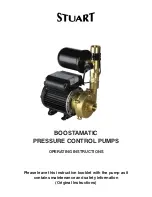
Hydraulic installations
Connecting a leakage drain
24
© Lutz-Jesco GmbH 2018
BA-10407-02-V08
Motor-driven diaphragm dosing pump
MEMDOS LB
Operating instructions
8.2 System piping
n
The system piping must not exert any force on the connections and
valves of the dosing pump.
n
This means that steel piping should be connected to the dosing pump
by means of flexible pipe sections.
n
The nominal diameters of the pipework and the installed fittings
should be rated the same as or greater than the nominal diameters of
the dosing pump's suction and pressure valves.
n
The suction line should be kept as short as possible.
n
You should avoid intertwined hoses.
n
Avoid loops, since air bubbles can collect.
8.3 Suction and pressure valves
Fig. 8: Dosing head with suction and pressure valves
The suction and pressure valves are hydraulic connections to the dosing
pump onto which the suction line or pressure line are attached.
These are double-ball bearing or spring-loaded valves which can only
work properly when mounted in a vertical direction. The condition of the
valves has a significant impact on the function and the dosing accuracy of
the dosing pump.
All valves have arrows on them, these indicate the flow direction. These
arrows must always point upwards.
For this reason, when connecting the dosing lines to the dosing pump,
observe the alignment:
n
Pressure valve above the dosing head,
n
Suction valve under the dosing head.
8.4 Connecting a leakage drain
Lutz-Jesco GmbH dosing pumps are produced to the highest of quality
standards with a long service life. However, some parts are subject to op-
erational wear. This is the case particularly with the diaphragms that are
continuously subjected to forces during the suction and discharge
strokes and to the effects of the dosing medium.
If a diaphragm ruptures, the dosing medium starts to leak. This leakage is
drained via the leakage opening. There is an opening on the dosing
head's flange for this purpose.
Fig. 9: Leakage drain opening
We recommend using a diaphragm rupture sensor.
DANGER
Danger to life through explosions!
If a diaphragm rupture sensor is installed in an explosive risk zone,
sparks may be produced when the electrical circuit closes. Explosions
may result which could result in fatal injuries.
ð
Only use electrical or electronic devices which are intrinsically safe
ignition protected.
NOTE
Damage to drives due to effervescent media
If a hose is connected to the leakage drain and it is routed back into the
dosing tank, effervescent media can enter the drive and damage it.
ð
Collect the leakage in a collecting pan.
ð
As an alternative, you can route the leakage back to to the dosing
tank using a funnel. You should install the funnel at an adequate
distance from the leakage opening.
















































